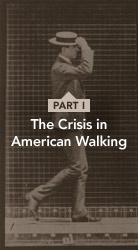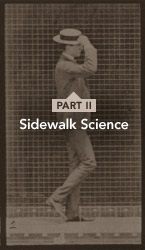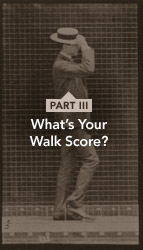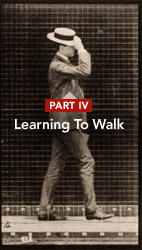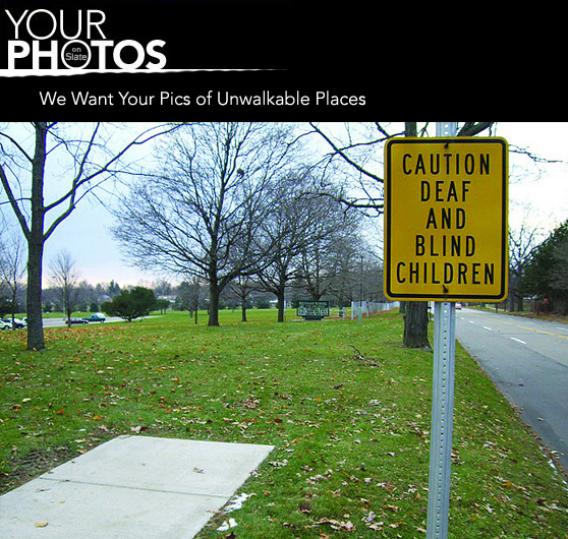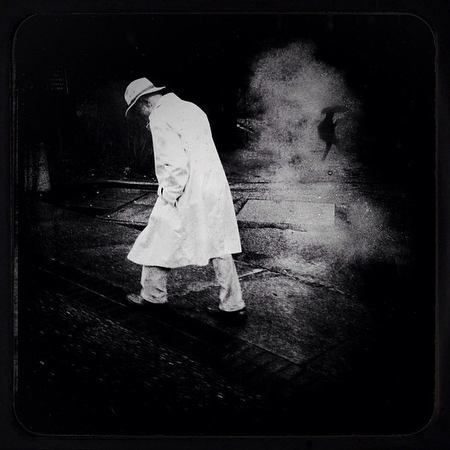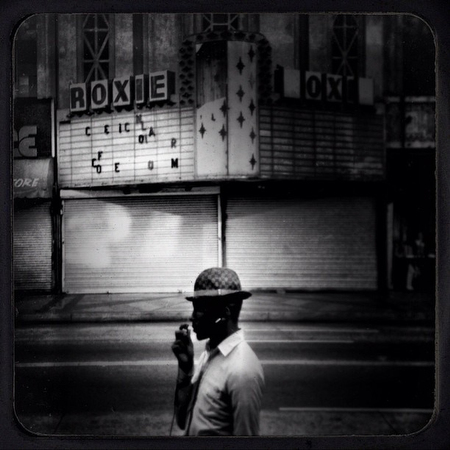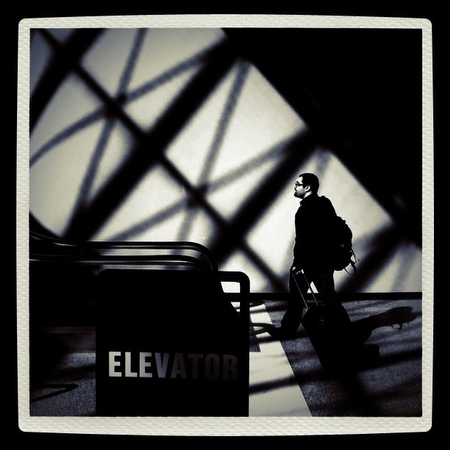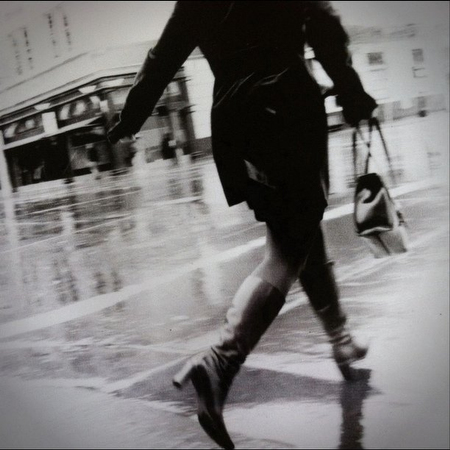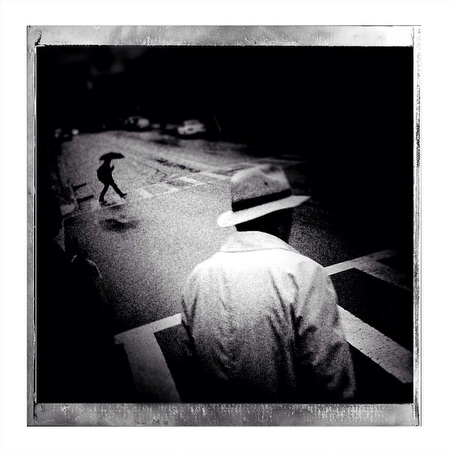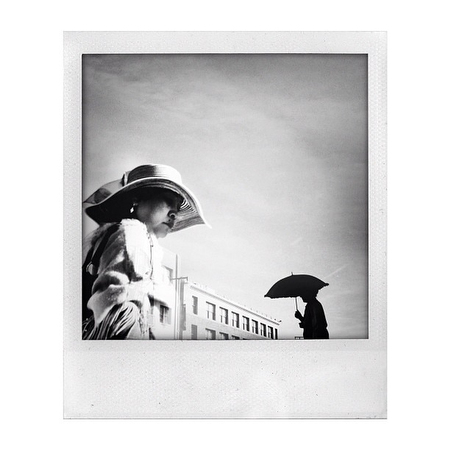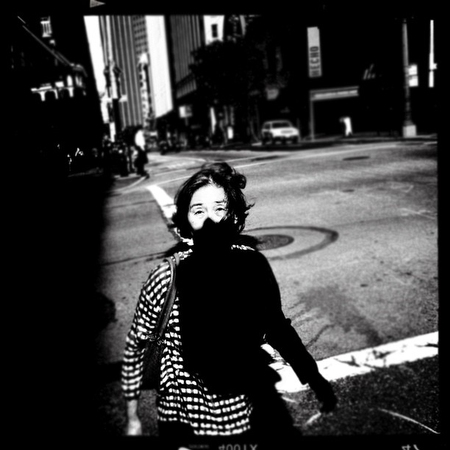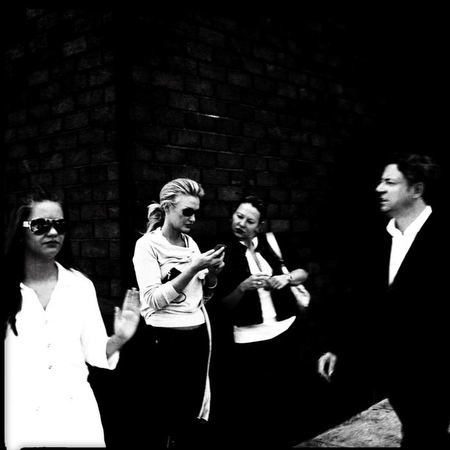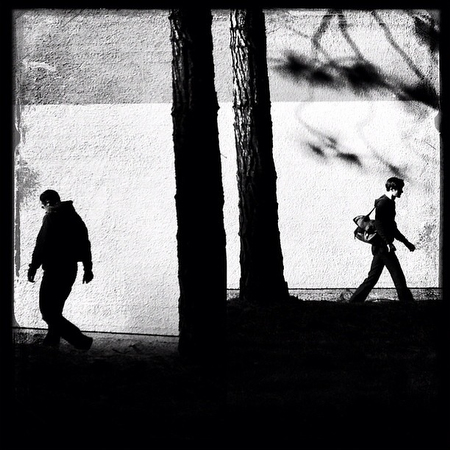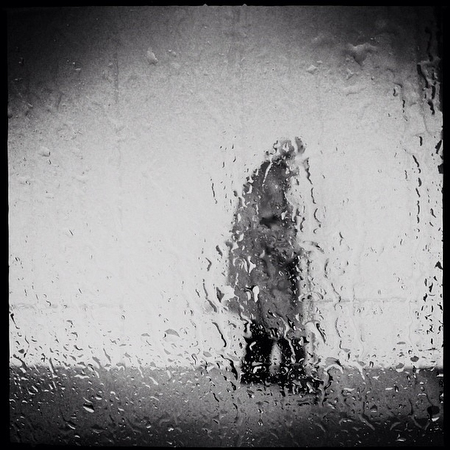Learning To Walk
How America can start walking again.
The plight of life on foot in America was nowhere more poignantly expressed than in the conviction, just last year, of a Georgia woman for vehicular manslaughter. What brought the case to national prominence was a single, Kafka-esque detail: She was not driving.
What happened? Raquel Nelson, having just disembarked from a bus across from her apartment complex, was crossing busy Austell Road with her four children when a driver—who admitted to having consumed a “little alcohol,” was on prescription painkillers, and is partially blind in one eye, and who already had two hit-and-run charges on his record, but a very active driver’s license—struck the group, killing her 4-year-old son.
The bus stop from which she’d alighted was directly across from the apartment complex that represented, in essence, its user base. And yet, transit users like Nelson were asked to walk one-third of a mile to the nearest traffic signal, on a narrow sidewalk abutting a street on which cars regularly drive 60 mph; to wait to cross at the intersection; and then to return another third of a mile. (To see for yourself just how daunting this is, head north from the apartment entrance on Google Street View.) At the time of the accident, Nelson and her family had been crossing directly at the bus stop, where there is no crosswalk. For this, Georgia prosecutors charged her with second-degree vehicular homicide. The driver, who was initially charged with “hit and run, first degree homicide by vehicle and cruelty to children,” later had his charges dropped to hit and run.
The charge against Nelson—akin to being accused of armed assault for stepping into the path of a bullet—raised the disturbing specter that she would face more jail time than the driver, Jerry Guy. On the strength of a chorus of outrage, a national petition organized by Transportation for America, and a sudden bout of judicial common sense, Nelson instead received a year’s probation and a chance at a retrial.
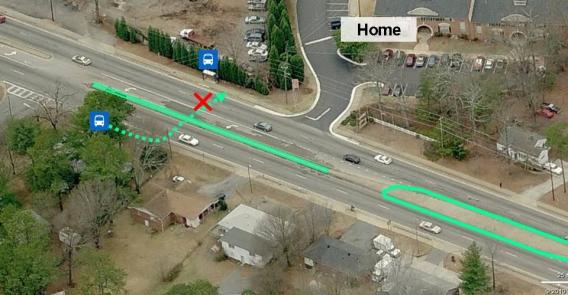
Courtesy Sally Flocks.
But if Nelson’s charge, and the subsequent outcry, was remarkable, the events leading up to it have become disturbingly normal. Austell Road, as this video depicts, is a busy, high-speed arterial highway. It is a forbidding environment for pedestrians, with Nelson’s apartment complex ranking a Walkscore of 23 (“car dependent”).
Even on more hospitable turf, people don’t like to walk two-thirds of a mile (or anything close to it) to catch a bus, something no one knows better than transit agencies themselves. The Snohomish County Transportation Authority in Washington notes, “People can be expected to walk no more than 1,000 feet to a bus stop or a park-and-ride parking space.” The Transit Capacity and Quality of Service Manual states, “most passengers (75 to 80% on average) walk one-quarter mile (400 meters) or less to bus stops.” The Federal Highway Administration notes, “bus stops should be positioned in locations that serve the highest numbers of pedestrians, minimize total walking distance, and reduce the number of roadway crossings for pedestrians.”
On college campuses, you have no doubt noted “desire lines” carved into grass quadrangles, where generations of students have chosen to articulate the shortest path, against the wishes of the space’s designers. If young, unencumbered, time-rich college students behave this way—shaving a few feet off of a journey—what might you expect a mother—burdened with four children, returning home at the end of the day, faced with the prospect of a lengthy and hazardous walk—to do? In the wake of the crash, rather than unveiling any of the standard safety treatments for helping get people across the road at transit stops—wider medians, narrowed travel lanes, curb extensions, pedestrian-activated crossings, etc.—the transit agency installed a poster in the bus-stop shelter urging its users to exercise caution.
One can find fault with the transit agency, with the state DOT, with Nelson herself—too easily labeled a “jaywalker” (see here for an unpacking of that word)—and certainly with Guy, a habitually dangerous driver. But in the arena of public health, blame is not a constructive avenue for changing behavior and reducing injury. After all, Guy could have been sober and driving the speed limit, Nelson could have been crossing in a marked crosswalk, with the same end result—where does blame get us then?
The more important question is: What were the conditions that helped contribute to the death of Nelson’s son? Highway engineers learned long ago that the best way to drive down injuries was not to blame the “nut behind the wheel,” but instead to reduce, through design, the possibility that a crash could happen—and to lessen the likely impacts of those that do. Consider, for example, that the sidewalks along Austell Road, which in an earlier age might have been behind trees, giving pedestrians a sense of comfort, are now nestled immediately against the highway. Why? To “forgive” the mistakes of drivers, who might otherwise smash into a tree. But there is no forgiveness for those on foot. Pedestrians, using the one mode of travel that cannot actively cause injury to others, must pay for their mistakes—and the mistakes of everyone else on the road.
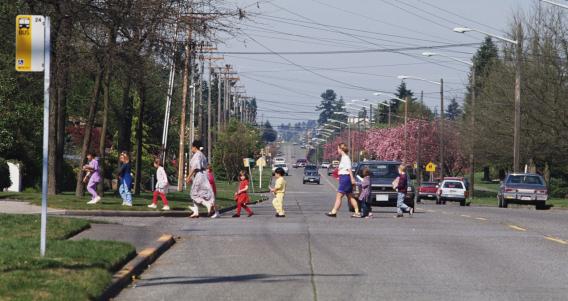
S. Meltzer/PhotoLink/Getty Images.
A large part of the problem is that places like Austell Road were built on the idea that there wouldn’t be anyone walking on them. Indeed, there wouldn’t be much of anything happening on them, except for cars speeding uninterruptedly from one dense town to another. This was the vision articulated by early optimists like Benton MacKaye and Lewis Mumford, who sounded their call for such roads in a 1931 Harper’s article called “Townless Highways for the Motorist.” Not only should highways avoid the centers of towns, they argued—in order to keep long-distance traffic from congesting already-busy urban thoroughfares— but those highways should themselves be free of commercial development. But even then, America’s fledgling highways were marked by “the familiar row of frontage developments—the peanut stand, the hot-dog kennel, the dewdrop inns, the superfluous filling stations with their cut whisky and applejack and their cut-price gasoline.” Today it’s more like Costco and Fatburger, but Mumford and MacKaye’s question still rings: “What is the use of a road's bypassing a town, only to find that the road itself has turned into a town—and a cheap, nasty town at that?”
But, as transportation engineer Walter Kulash says, “the fact that 50,000 travelers a day are bundled together makes [roads] irresistible to commerce.” And so the high-speed suburban arterial became a kind of American Main Street. The presumption has always been that this is a boon for traffic safety—in place of crowded downtowns with their narrow streets, busy intersections, and innumerable “conflicts,” there were wide, obstacle-free roads with generous sightlines and capacious parking. But the work of Eric Dumbaugh, a professor of urban and regional planning at Florida Atlantic University, has shown precisely the opposite: It is the suburban arterials, not downtowns, that represent the most significant driving hazard. The combination of high speed and “access”—i.e., being able to zip in and out of that drive-thru—is a dangerous cocktail. That strip mall with your favorite frozen yogurt joint? “A single strip commercial use,” writes Dumbaugh, in an article in Journal of the American Planning Association, “would be expected to produce up to 6 times more crashes than one would expect to occur from one million miles of vehicle travel alone, and a single big box store up to 14 times more crashes.” That crowded street in town? It’s linked with “significant reductions in crashes.”
What’s more, these arterials were typically built without any provisions for people walking—because who would be? And yet, drive down one of these streets and it’s not uncommon to see, adjacent to the multimillion-dollar, rigorously designed road infrastructure, a narrow “goat track” etched into the grass. These DIY paths might be used by someone getting off a bus and still having to walk a quarter mile to get to his fast-food or domestic-service job; it could be a young person walking to the mall. They are as invisible to society as they are to the average driver.
This failure to plan for anyone on foot is just one of a number of shortcomings of our overbuilt, undermaintained road network that are coming into relief. In Orlando, parents of children who live closer than two miles to school are worried about looming cuts in bus service due to budget constraints. There is even concern about those who face a relatively short walk of 100 yards to catch a bus. Why? Because the environment was not built to accommodate anyone walking—there are no sidewalks and only poor crossings amid fast-moving traffic. Elsewhere, schools built without sidewalks scramble for funding as students walk in the ditches beside busy roads. In South Jordan, Utah, a woman was cited with child neglect for allowing her son to walk to school. Why was he walking? Because the school had eliminated its “hazardous bus routes.” What’s a hazardous bus route? A bus route meant to pick up kids who live in areas without sidewalks. There is child neglect going on here, for sure, but it’s the neglect of a system in which children within walking distance of school cannot actually do so.
Peter Lagerwey*, a transportation engineer (and former bicycle-walking coordinator of the city of Seattle), has observed a common pattern: “There’ll be an arterial street in a semi-rural area on the edge of town, and then the issue of sidewalks comes up. Well, this is country, so you don’t put [sidewalks in] at the time the road is widened or developed. Then eventually things get built up. By then the chance to get it built is gone, as it transitions from semi-rural into suburban,” he says. “The time you realize you need pedestrian infrastructure, it’s too late.”
There is not a single dollar in the U.S. federal transportation budget dedicated strictly to walking. While programs like TIGER (“Transportation Investment Generating Economic Recovery”) or T.E. (“Transportation Enhancements”) have allocated money toward walking (or bicycling) projects, that money is not earmarked especially for pedestrian projects, says Barbara McCann, director of Complete Streets, and “a very small amount gets used that way.” As a Federal Highway Administration study noted, “In 2009, about 2.0 percent of federal-aid surface transportation funds were used for pedestrian and bicycle programs and projects. However, those two modes are estimated to account for almost 12 percent of all trips and represent more than 13 percent of all traffic fatalities.”
The funding mismatch, argues McCann, stems from “inertia” in a transportation-engineering profession that came into full being during the building of the Interstate Highway System. “The idea was moving cars around, as quickly as possible, without accounting for the fact that not everyone can get there by car—in fact, about one third can’t.” (Her figure includes children and others who do not drive.) It wasn’t until 1991’s Intermodal Surface Transportation Efficiency Act (which wonks call “Ice Tea”) that the idea of using federal dollars to promote walking was even broached, with a plan to distribute nearly $800 million toward “active transportation” (read: walking and cycling) projects. Even then, “ISTEA didn’t live up to its promise,” McCann says. “The idea was to create innovative programs … to help DOTs learn to do things differently, then to expand that into the 'mainstream' programs. While spending on ‘alternatives’ went up, in all but a few places they never went from being ‘alternatives’ into being part of the mainstream of transportation project delivery.” Indeed, the recent congressional transportation bill (which even some Republicans think is too draconian) aims to kill off even the possibility of funding for walking—to the point of eliminating popular programs like “Safe Routes to School.”
Of course, once upon a time, providing provisions for walking was the natural province of local figures. As Anastasia Loukaiou-Sideris notes in Sidewalks, 19th-century sidewalks were typically paid for by abutting property owners, and were generally cleaner and better paved than roadways. Even in the infancy of the car, however, the call came to widen city streets—at the expense of sidewalks—for traffic circulation. As the country increasingly moved to the suburbs, the things that people needed to get to, like jobs and stores, were getting further from home. People were walking less, so fewer accommodations were made for walking. A kind of vicious circle was set in motion, Loukaiou-Sideris says: “Eventually public leaders became concerned that providing sidewalks might encourage people to walk in environments that were considered unsafe.”
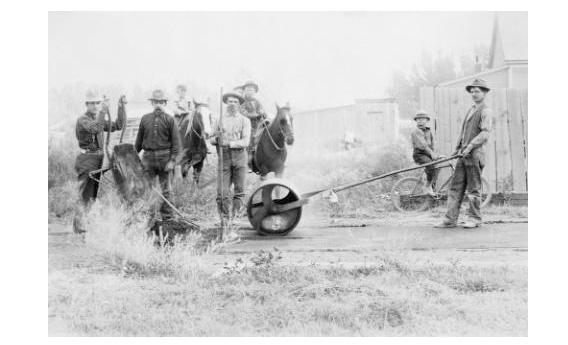
Western History/Genealogy Dept., Denver Public Library/Library of Congess.
Subtle changes in land use made walking less appealing. As Michael Southworth and Eran Ben-Joseph write in Streets and the Shaping of Towns and Cities, where it had once been customary in U.S. cities and towns to plant street trees between the sidewalk and the street, in the 1930s and 1940s that policy shifted: The sidewalk (and pedestrians) would now shield cars from the danger of the trees. This change increased the perceived width of the street, and hence the speed of drivers—which struck another blow against walkers. Around the same time sidewalks began to be seen as optional in many subdivisions (and are still resisted by some homeowners), which is ironic given the preponderance, in suburbia, of children and others for whom walking was critical. A 1957 paper by the American Planning Association sounded a prophetic note: “If sidewalks are needed in new developments now, it is hard to avoid the conclusion that they will be needed even more in the future.”
But they weren’t built, or weren’t built properly, and so communities across the country are now calling up people like Seattle’s Lagerwey to come in and retrofit their towns. Lagerwey, for his part, says it’s not necessarily an anti-pedestrian ideology that leads to unwalkable places. “Sometimes it’s just a glitchiness in the way we decide to fund things,” he says. “You’re responsible for doing the sidewalk in front of your business, and once you get there, it just sort of stops.” Hence the profusion of what might be called “phantom sidewalks” in suburban communities: Little stub ends of pavement that simply end. “We find a way to make roads connect,” he says. “We haven’t done that with sidewalks.” Not that sidewalks are the only answer. “If you have a four-foot sidewalk next to a high-speed travel lane, no one’s going to walk there.” The most important element of pedestrian infrastructure is, he argues, not the sidewalk; rather, “it’s getting across the street.” He invokes a “three-legged stool” of factors that make walking desirable, and possible: safety, accessibility, and aesthetics. Each helps support walking. Scott Bricker, of America Walks, notes that when he moved into a gentrifying neighborhood in Portland, Ore. he noticed people walking in the street, even though there were adequate sidewalks. “They didn’t want to get bitten by the pit bulls in people’s yards,” he says. “The chains were just long enough to get the edge of the sidewalk.”
As Lagerwey travels, like some kind of traffic whisperer, to places like San Antonio, he routinely encounters a similar set of problems. “It’s certainly nice to have sidewalks, but the biggest problem is the width of our streets, the speed of our streets, the high traffic volumes and geometrics of the intersection—you just can’t get across,” he says. “If you have fewer lanes, tighter curb returns, lower speeds, then it works for pedestrians.” Shorter blocks are key too. “We don’t build enough streets,” he says. Rather, we have superblocks. “The visual messaging is go fast. The blocks are really long, you pick up speed between them. The town may not allow street parking, which gives it a wider feel. They haven’t put in street trees because they put a sidewalk where the trees should go. The houses are set way back.”
People often fall prey to what might be called the “cul-de-sac” illusion. As Lagerwey says of the so-called “lollipop suburbs,” where winding, unconnected streets terminate in cul-de-sacs, “in theory you have a low-volume street, low speed. Kids can play and it’s really safe,” he says. “What they discover, of course, is that there’s no place to go.”
I am not suggesting that the United States is suddenly going to become Manhattan, or that it should. But how much potential walking do we nip in the bud with our lack of sidewalks, our dangerous crossings, our unconnected pedestrian networks? Research by Stephanie Rosenbloom shows that among people 65 and over—one in five Americans in 2030—one-half reported having a food store and a pharmacy within a half mile of their home, but only 5 percent of all trips they take are on foot. It’s no mystery why, and it’s not laziness or infirmity: Bricker says surveys by AARP have found that one-half the people it interviewed aged 50 and higher said they couldn’t safely cross the main street closest to them. Lagerwey cites the foot traffic at a nearby mall as litmus test. “The more people you see mall walking the more of a reflection of how bad it is in neighborhoods,” he says. “If I was a senior I’d go to the mall too.” Similarly, the treadmill, which Rebecca Solnit in Wanderlust describes as an idea first devised as a medieval punishment, now looms as a symbol of non-mobility: “a device with which to go nowhere in places where there is now nowhere to go.”
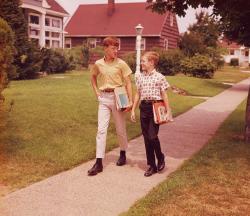
H. Armstrong Roberts/Retrofile/Getty Images.
It is true that Americans tend to inhabit lower density regions than people do in Europe, but as a study by transportation researcher Ralph Buehler and colleagues found, Germans who live in lower density regions travel by car about as much as Americans living in areas that are five times denser. Germans walk more for a range of reasons: better walking facilities, better connections with transit, better transit (which itself encourages more walking), stronger financial incentives (e.g., higher gas prices), better land-use decisions, and because it’s safer to walk in Germany than in the United States. Even Canada, whose broad geography might imply more car trips than in the United States, walks or cycles twice as much as we do.
As Walk Score demonstrated, people are talking about walkability, but what are they actually doing about it? One of the most encouraging trends is the so-called “Complete Streets” movement, which grew, says director Barbara McCann, out of an old idea, promoted by non-motorized-transportation wonks, called “routine accommodation.” “This was the idea that every time you look at a road you consider the needs of cyclists,” she says. “It was immediately clear to me that this was about more than bikes.” Drawing on input from a range of interested parties, from America Bikes to the AARP, Complete Streets moved from a concept to a set of guidelines for communities to adopt into policy (if not always actual practice); nearly 300 U.S. jurisdictions have signed on, with more this year than in any previous.
What does a complete street look like? “Ironically, we don’t talk about a complete street,” says McCann. “There’s lots of ways to have complete streets.” Whatever the measure, however—bike lanes, roundabouts, bus stops, median islands, narrower roads—the idea harkens back to an idea that was essentially rendered obsolete in the early 20th century as the car began its ascent: that the public road is intended for more than one mode of transportation. While these sorts of changes might seem to run counter to the interests of car drivers, complete-street design modifications can actually make things better for drivers—not merely in terms of safety, but by providing a more rationalized driving experience, with little or no impact on overall traffic flow. Through design changes, Complete Streets hopes to effect behavioral change. “People ask me if Complete Streets should have an enforcement side,” McCann says. “But the road itself should send signals. If you have a road with 12-foot lanes and clear zones, it’s safe for you to open up the throttle and you see the pedestrian scuttling across the road and think ‘they’re in my way.’ ” But add a raised crosswalk, trees, and narrow the road, says McCann, and “this is signaling to you, without a stop sign, that there are going to be all these other users, that you need to pay attention.”
While walking-challenged small suburban communities have been the most frequent adopters of Complete Streets’ guidelines, even walkable cities like New York, San Francisco, and Chicago—where generations of spatial concessions to the car have downgraded the pedestrian experience—are embracing a complete-streets mentality. Interestingly, what’s driving much of this activity is a renewed interest not simply in walking as a transportation mode, but in health. The notion of walking as an anti-obesity measure, among other things, has moved the Centers for Disease Control to support “active transportation.” And some cities are supporting walking with an epidemiological approach: Rather than viewing pedestrian injuries as random accidents to be blamed on wayward jaywalkers, cities are now employing health professionals to pinpoint where and why people walking are injured.
Consider, for example, Rochelle Dicker, a surgeon who has been brought into San Francisco’s efforts to reduce pedestrian injury. In her role as surgeon, many of the patients she sees are people struck by cars. “There’s nothing like seeing these injuries up close again and again that motivates you to do something about these issues,” she says. “It really compelled me to look at it from a different angle—not just trying to fix people after they get injured, but what we can do on a policy level to make our city safer.” Along with colleagues, she examined records on four years worth of pedestrian injuries treated in the trauma center at San Francisco General Hospital. Her study took an unusual tack: putting a public price tag on pedestrian injury. The reasoning? Find the costliest “hotspots,” and target those with countermeasures. “There’s just a finite amount of resources to put toward prevention,” she says. “Where are you going to get the biggest bang for your buck?” The total price tag for four years of pedestrian injury in San Francisco: more than $20 million, with more than three-quarters paid for with public funding.
When a pedestrian is struck by a car, the resulting injury is often severe—and costly. “When average-sized adults get hit, they are hit in the legs and get flipped,” says Dicker. “Their head hits either the hood or the pavement.” Severe head injuries tend to require ICU time, as well as substantial rehab. But the personal and societal costs are even greater: Severe head injuries represent one of the top reasons why people are unable to return to work.
The countermeasures that Dicker suggests are things like “pedestrian countdown signals,” which perform the simple task of telling a person how much time they have left to cross the street. (Research showed the signals helped reduce crashes in San Francisco.) She also mentions the elevated walkways of Las Vegas. “They have elevated pedestrian bridges that are completely separated from the Strip,” she says. “Any time you can separate pedestrians from cars like that, that’s the best. It’s also the most costly.” And yet the idea of a city in which pedestrians and cars never intersect, an old modernist dream—aptly described by Stephen Marshall: “[T]here would be no pub on the corner, since no building would interfere with the requisite junction visibility requirements. There would be no crossroads, since these would be banned on traffic flow and safety principles. Indeed, there would be no ‘streets’: Just a series of pedestrian decks and flyovers”—has proven to be not only technically unfeasible, but counter to the idea of what a city should be.
Ian Lockwood, a transportation engineer based in Florida, makes the point that the moment in many people’s lives when they have the most freedom is when they go on vacation. “It is during their precious vacation time, with increased freedom to choose, when people willingly walk, ride bicycles, and ride public transit.” People, argues Lockwood, want urban experiences, whether that means European cities, Disney World, or even cruise ships. Few people choose to spend that precious free time on an automotive tour of a sprawling exurb. (“Look, another big-box store!”) True, these may be, at heart, fantasy environments—Venice is as much an illusion in the modern world as Disney—but can’t some of what’s memorable and distinct about those environments be brought back home? Rather than go to where we can walk, why can’t we walk to where we want to go?
*Correction, May 28, 2012: This piece originally misspelled Peter Lagerwey's last name. (Return.)
More from this series: The troubling fact that Americans walk less than almost anybody; what scientists learn when they study pedestrians; how Walk Score has put a number on walkability.
